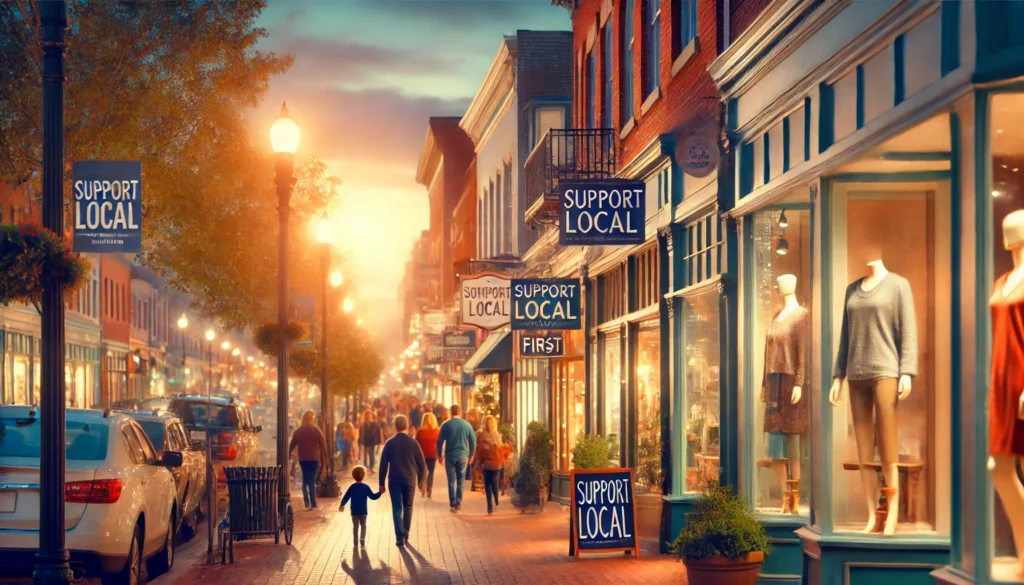TREND: Retail Big Split what small town retailers can do now
TREND 2025: Retail Big Split – What Small Town Retailers Can Do Now
The retail industry is undergoing a transformative phase, a phenomenon more aptly described as “Retail Big Split” rather than the Retail Apocalypse. While the era of big-box retail dominance diminishes, small-town retailers have the opportunity to thrive by adopting innovative strategies, embracing technology, and creating meaningful shopping experiences. This article outlines the causes behind the shift, its implications for small retailers, and actionable steps they can take to succeed.

Table of Contents
- Understanding Retail Big Split
- Definition and Historical Context
- Differences from the Retail Apocalypse
- The Decline of Big-Box Retailers
- Automation and Online Shopping’s Role
- Societal Trends: Sustainability and Minimalism
- The Rise of Small Retailers
- Consumer Preferences for Local and Curated Shopping
- The Importance of Community Connections
- Evolving Consumer Behaviors
- The Shift to Automated Purchases
- Demand for Unique and Meaningful Products
- Technology as an Equalizer
- Leveraging Digital Tools in Small Retail
- Examples of Successful Technology Integration
- Creating Memorable In-Store Experiences
- Classes, Demonstrations, and Events
- Personalized Shopping Services
- Curated and Sustainable Products
- Focus on Local Artisans and Handcrafted Items
- Benefits of Supporting Sustainable Practices
- Integrating Physical and Digital Retail
- Building an Omnichannel Presence
- Utilizing Online Reviews and Recommendations
- Enhancing Customer Relationships
- Using Technology for Personalization
- Encouraging Loyalty Through Unique Offerings
- Embracing Small-Town Charm
- Leveraging Community Identity
- Creating Spaces that Reflect Local Values
- Learning from Big Retail Tactics
- Automatic Reordering and Subscriptions
- Delivery Services for Small Businesses
- Adapting to the New Retail Landscape
- Preparing for Continued Automation
- Staying Agile with Changing Consumer Preferences
- Case Studies: Small Retail Success Stories
- Insights from Rural Shops Across North America
- Lessons from International Small Businesses
- Overcoming Common Challenges
- Addressing Weaknesses in Small Retail
- Turning Limitations into Strengths
- Actionable Strategies for 2025 and Beyond
- Steps to Capitalize on the Retail Split
- Long-Term Vision for Sustainable Growth
Understanding Retail Big Split
Retail Big Split refers to the divergence in consumer shopping habits, where routine, automated purchases shift to eCommerce, and meaningful, personalized purchases favor small, local retailers. Unlike the apocalyptic narrative of the 2017 Retail Apocalypse, this shift highlights opportunities for small businesses to redefine retail experiences.
James Kunstler’s 2013 prediction of big-box retailers facing a “scale implosion” is becoming reality. Today, consumers prioritize convenience for essentials and connection for discretionary purchases, paving the way for small-town stores to thrive.
The Decline of Big-Box Retailers
Automation and Online Shopping
Big-box stores are losing relevance as routine purchases move online. Innovations like smart refrigerators and automated reorder systems have diminished the need for physical trips to buy essentials like detergent or paper towels.
Societal Trends
Cultural shifts toward sustainability and minimalism also contribute to the decline. Consumers increasingly turn to secondhand stores, vintage shops, and local artisans, reducing demand for mass-produced items.
The Rise of Small Retailers
Small retailers are benefiting from a growing preference for personalized, local shopping experiences. Consumers seek charm, beauty, and connection in their shopping, as noted by author David Sedaris, who emphasized the value of small, curated stores over impersonal superstores or websites.
The Importance of Community
Small-town retailers have a unique ability to create meaningful community connections. They offer products and services that align with local values, enhancing customer loyalty.
Evolving Consumer Behaviors
Automated Purchases
Routine shopping is increasingly handled through automation. Voice assistants like Alexa and Siri streamline the buying process for essentials, leaving more room for consumers to focus on experiential shopping.
Meaningful Purchases
When shopping for non-essentials, consumers prioritize quality, craftsmanship, and sustainability. They value the story behind products and the experience of purchasing them.
Technology as an Equalizer
Small-town retailers can level the playing field by leveraging technology:
- Point-of-Sale Systems: Streamline inventory and sales tracking.
- Digital Marketing: Use social media and targeted ads to reach local audiences.
- Customer Relationship Management (CRM): Personalize shopping experiences and improve customer retention.
Creating Memorable In-Store Experiences
Memorable experiences distinguish small retailers from big-box competitors:
- Classes and Demonstrations: Hosting workshops, such as craft classes or product demonstrations, fosters community engagement.
- Interactive Displays: Allow customers to interact with products, enhancing the shopping experience.
Curated and Sustainable Products
Small retailers can emphasize:
- Local Artisans: Partnering with local creators adds authenticity.
- Eco-Friendly Practices: Highlighting sustainability resonates with modern consumers.
Integrating Physical and Digital Retail
An omnichannel approach combines the best of both worlds:
- E-Commerce Platforms: Enable online shopping for local customers.
- In-Store Digital Tools: Use tablets for product reviews and recommendations.
Enhancing Customer Relationships
Technology can help small retailers build stronger customer relationships:
- Personalization: Offer tailored product recommendations and services.
- Loyalty Programs: Reward repeat customers with discounts and exclusive offers.
Learning from Big Retail Tactics
Small retailers can adopt strategies from big-box stores, such as:
- Automatic Reordering: Offer subscription services for frequently purchased items.
- Delivery Services: Provide local delivery options for convenience.
Actionable Strategies for 2025 and Beyond
Small-town retailers can capitalize on Retail Big Split by:
- Embracing technology to improve service.
- Offering unique, locally-made products.
- Creating memorable shopping experiences.
- Leveraging community identity to strengthen brand loyalty.
-
15 Best AI Tools for Developers in 2025 (Free & Paid)
15 Best AI Tools for Developers in 2025 (Free & Paid) The rise of artificial intelligence is transforming how developers write, debug, and optimize code. From automating repetitive tasks to predicting errors before they happen, AI tools are becoming indispensable for coders in 2025. Whether you’re a Python pro, a JavaScript enthusiast, or a full-stack…
-
Easy Ways to Prepare for AWS Questions in 2025
Mostly Asked AWS Interview Questions in 2025 Impact-Site-Verification: c45724be-8409-48bd-b93e-8026e81dc85aAmazon Web Services (AWS) has consistently remained at the forefront of cloud computing. With organizations migrating their infrastructures to the cloud, AWS-certified professionals are in high demand. Cracking an AWS interview in 2025 demands not just conceptual clarity but also hands-on familiarity with AWS services. In this…
Conclusion
The era of Retail Big Split presents unprecedented opportunities for small-town retailers. By adopting technology, fostering community connections, and creating meaningful shopping experiences, they can thrive in a changing retail landscape.
Frequently Asked Questions (FAQs)
- What is Retail Big Split?
It describes the divergence where routine purchases shift online, and meaningful purchases favor small, local retailers. - How can small retailers compete with big-box stores?
By leveraging technology, offering personalized services, and focusing on community engagement. - What role does sustainability play in retail today?
Consumers increasingly prefer eco-friendly and locally-sourced products, benefiting small retailers. - Why are experiences important in retail?
Memorable experiences differentiate small retailers and foster customer loyalty. - What technology should small retailers adopt?
Point-of-sale systems, CRM tools, and online shopping platforms are essential. - How can small retailers prepare for the future?
Embrace automation, adapt to changing consumer preferences, and maintain flexibility.



